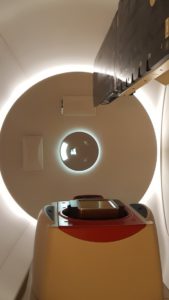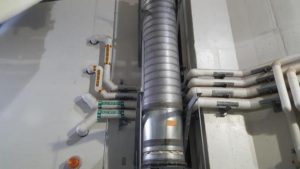Subscribe Now
BIM Technology Enables Revolutionary Cancer Care: The Inova Schar Cancer Institute Story
The Inova Schar Cancer Institute is a full-service cancer treatment center and includes the Inova Mather Proton Therapy Center, which is the first proton treatment center in Northern Virginia, revolutionizing cancer care with cutting-edge technology. The treatment with pencil beam scanning targets malignant cells while leaving healthy ones unharmed, sparing adjacent healthy tissue.
 The Inova Hospital System made the decision to embark on implementing this new proton treatment within its Inova Center for Personalized Health Campus, as part of a strategic initiative to broaden the hospital’s ability to provide leading-edge patient care and bring top-quality cancer treatment closer to home. The two-room IBA Proteus Plus proton therapy solution demanded its own dedicated space, an additional facility adjacent to the existing hospital building to ensure its safe and accurate operation.
The Inova Hospital System made the decision to embark on implementing this new proton treatment within its Inova Center for Personalized Health Campus, as part of a strategic initiative to broaden the hospital’s ability to provide leading-edge patient care and bring top-quality cancer treatment closer to home. The two-room IBA Proteus Plus proton therapy solution demanded its own dedicated space, an additional facility adjacent to the existing hospital building to ensure its safe and accurate operation.
The pioneering nature of the proton therapy technology, coupled with an intense construction process that did not just require accuracy, but unwavering precision, required a multi-leveled approach to execute this project. In addition to massive amounts of tradespeople and activity happening throughout, BIM technology played a critical role in the solution developed to address key challenges.
Key challenges and solutions of the project included:
- Varying levels of complexity – from start to finish. The large task list and level of complexity this project demanded required seamless coordination of activity and resources. To get a sense for what was involved, the team traveled to Florida to see the new technology in action before beginning work. The data and background gathered – in combination with the BIM technology used to plot key steps and sequences – enabled top quality in workmanship throughout the project.
- Design elements dictated by equipment. An unconventional element of this project was the design plans for the new building were directly dependent on the proton equipment’s needs. This began with determining the optimal placement for the machine within the concrete walls and plans for how the pipe and fittings would be laid around it. Due to the radiation produced by the machine, the pipe penetrations into the new therapy room facility had to include a z-bend as a safety measure to prevent radiation from passing through the pipes themselves. The project team virtually placed the pipe fittings into the wall model and used this approach to plot the actual sequence of the installation and order of steps to achieve it successfully, the first time. Surveyors with robotic stations were mobilized at the BIM stage to map out all pipe support locations and checkpoints and to ensure the model created was executed to 100% accuracy before moving forward.
- No option for re-work. Deployment of BIM technology allowed the project team to strategically map precise locations of piping and fittings ahead of time. BIM was also used to create the model for the rebar placement to ensure pinpoint accuracy, essential to the concrete pouring of the walls surrounding the Proteus Plus unit. Quality control played a vital role, as well, in ensuring the project was done right the first time. Double- and triple-checking took place in the field in order to be certain everything was correct before the concrete pouring took place.
- Tight time constraints and steep learning curve. The project team’s in-house prefabrication team played a key role in bringing the skills needed to conduct the required stainless steel welding. This provided the project with process chilled water pipe and fittings in prefabricated assemblies produced in a clean, safe and controlled environment providing for the highest quality of craftsmanship and just in time delivery.
The project involved numerous complexities on a massive scale. No safety incidents were reported despite a number of risky, challenging activities that took place, including tradespeople standing on plywood as the 16-foot-thick concrete walls were bring poured, to walking across the rebar itself to precisely coordinate piping sequencing. This, in addition to a safety challenge, required top attention and expertise from each member of the field team in order for the project to be executed successfully.
 The Inova Mather Proton Therapy Center opened and treated its first patient on March 9. The project team included Shapiro & Duncan, Wilmot/Sanz, Inc. and Clark Construction.
The Inova Mather Proton Therapy Center opened and treated its first patient on March 9. The project team included Shapiro & Duncan, Wilmot/Sanz, Inc. and Clark Construction.
View the BIM project here: https://www.youtube.com/watch?v=faKY2YPKZCc&t=3s
Project details submitted by Ron Churchey, vice president of Construction at Shapiro & Duncan, Inc.
Tags: BIM, Construction
Posted November 16, 2020
More Articles:
- Coverings 2024
Apr 22, 2024 – Apr 25, 2024 - Hospital, Outpatient Facilities & Medical Office Buildings Summit
Apr 25, 2024 – Apr 25, 2024 - CxA Workshop & Exam
Apr 29, 2024 – Apr 30, 2024 - EMP Seminar & Exam at CxEnergy 2024
Apr 29, 2024 – Apr 30, 2024 - CxEnergy
Apr 29, 2024 – May 2, 2024 - PHCC West 2024
Apr 29, 2024 – May 2, 2024 - Lean in Design Forum 2024
May 1, 2024 – May 2, 2024










